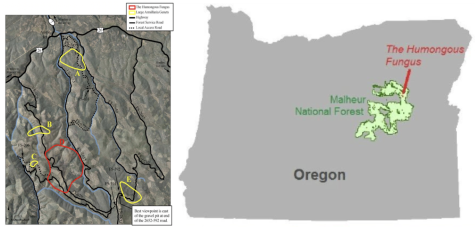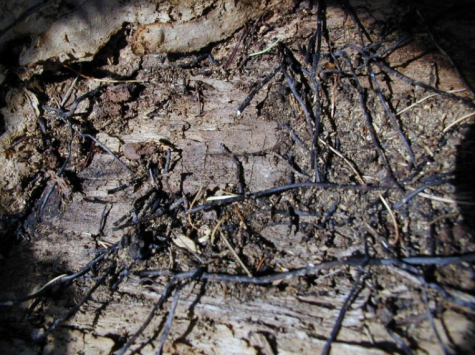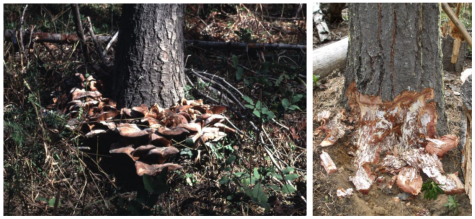The Organism Beneath Oregon
March 31, 2023
When we think of large organisms, we often think of animals such as the blue whale measuring 220 tons or the towering Sequoia redwood trees of California measuring up to 1,350 tons. Yet, the largest single organism on Earth is neither a plant nor an animal, but a fungus.
In eastern Oregon, within the bounds of the Malheur National Forest, is the largest single organism on Earth: estimated to weigh anywhere from 7,500 to 35,000 tons. Living underground and feeding off of the roots of coniferous trees, this fungal mass is a pristine specimen of the species Armilleria ostoyae. As seen below, it covers a surface area of 2,385 acres, with several other large genetically unique growths, known as genets, in its vicinity. As seen in red below, this fungal growth is known as Humongous Fungus, or Genet D.

Left: A map of part of the Malhuer National Forest, showing the largest genets of Armilleria ostoyae in the region.
Right: Genet D, in red, compared to the entire state of Oregon.
Genet D, Humongous Fungus, is estimated to be anywhere from 1900 to 8650 years old, based on the genet’s sheer size, and the various rates at which it might have grown each year based on recent data. Yet, even as such an old and massive organism, it is barely visible, living under the ground until it infests a host. As aforementioned, A. ostoyae mainly feeds off of the roots of coniferous trees, killing them slowly and creating large patches of fallen or soon-to-fall trees. Yet, their mycelium spreads throughout the tree, not just infesting the roots. Once the tree is killed, A. ostoyae begins to feed off of the decaying material, meaning it is both a saprophyte and a parasite. In addition, mycelium and other fungal growths of A. ostoyae have been found in/on other woody plants, such as willow, alder, and some deciduous trees. That being said, due to their parasitic and saprophytic nature, infestations of A. ostoyae have been termed “Armilleria disease” or “Armilleria root disease” referring to the spread and infection of the fungus in forests.
So, how does A. ostoyae spread? Like any other fungus, it reproduces through spores, but also spreads using mycelium, which A. ostoyae has uniquely adapted to be able to do. Granting it the name “shoe-string fungus”, the mycelium “roots” seen below make up the majority of the mass of Genet D, and the majority of the mass of any A. ostoyae growth. These mycelia are what infest the roots of trees, and can thus be seen in wind-blown root-balls

The “shoe-string” mycelium “roots” of A. ostoyae in the root system of an infested tree.
Yet, these mycelia aren’t the only growth of A. ostoyae, as they do produce a fruiting body: a mushroom. As seen below, A. ostoyae mushrooms sprout from the soil and roots of infested trees in the mid to late fall, and produce spores, spreading the parasitic fungus even more. Furthermore, as seen below on the right, thin mycelium “felts”, something common amongst both parasitic fungi and saprophytes, can be found under the bark and between decaying layers of wood in infested trees.

Left: A. ostoyae mushrooms. Right: A. ostoyae mycelium felt in an infested tree.
From a mass larger than any other living thing on Earth to specialized “roots”, this Armilleria ostoyae specimen is an outstanding example of the evolution of fungus. Genet D, Humongous Fungus, located in the Malheur National Forest in Eastern Oregon is the largest known genet of A. ostoyae in the world, and the largest single organism in the world. This leads the mind to wonder if the gargantuan hidden mass of Humungous Fungus may mean there are even larger organisms on our planet that we simply can’t see.





Jennifer Swander • Mar 31, 2023 at 4:13 pm
Wow! This could destroy whole forests if not monitored! I usually think of fungus as a positive part of the eco-system when I’m foraging mushrooms like king boletes around here, so thanks for bringing our attention to a very different aspect.